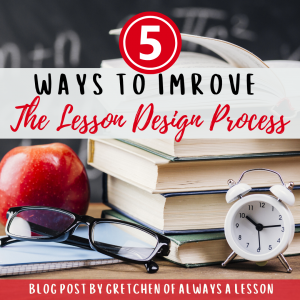5 Ways to Improve the Lesson Design Process
Lesson design is the art of preparing a lesson that takes into account the minor details required for an effective learning experience for all students. When teachers design lessons instead of just prepare them, proficiency for staff and students increase.
This blog post will reveal five ways to improve the lesson design process so that teachers can be more effective in the classroom.
Focus on the design process, not the paper lesson plan.
 Turning in lesson plans a month in advance promotes compliance over skillful planning. Requiring all teachers to use a specific lesson plan format emphasizes filling in the requirements instead of relying on teacher personality and expertise to design instruction. The goal of lesson design is to plan effective learning experiences for all students present in the classroom. Breaking out of compliance measures while also providing boundaries, ensures quality planning occurs that produces increases in student outcomes.
Turning in lesson plans a month in advance promotes compliance over skillful planning. Requiring all teachers to use a specific lesson plan format emphasizes filling in the requirements instead of relying on teacher personality and expertise to design instruction. The goal of lesson design is to plan effective learning experiences for all students present in the classroom. Breaking out of compliance measures while also providing boundaries, ensures quality planning occurs that produces increases in student outcomes.
Implement a nonnegotiable, quarterly backwards design planning day.
Planning instruction is time consuming, especially if teachers want to do it well. Having a road map for what content to cover, when, and for how long is extremely helpful when sitting down to plan. Dedicating half a day to a full day for a team of teachers to come together to plan the roadmap for the upcoming quarter eliminates the burden of planning being too time consuming to do a thorough job. This needs to be a protected instructional practice for all teachers in every school building during every school year.
Prepare a flexible gradual release lesson delivery format.
Gradual release refers to passing ownership from the teacher to the student during a lesson. Typically a lesson will transition from direct instruction to guided practice and end with independent practice with or without an assessment. Many teachers follow this lesson format religiously; however, it often lacks flexibility. Moving to the next portion of the lesson because pacing says so means students are pushed forward before they are ready, causing lack of understanding and lower performance. Adding flexibility means teachers use pacing in addition to gradual release but build in check for understanding practices to determine when students are ready to move forward in the lesson content. As a result, some lessons will move forward quickly and others will move slowly. Flexibility ensures teachers are using a responsive instruction approach.
Get specific with time management and pacing.
Speaking of pacing, managing time during the planning process aids teachers in successfully executing the learning experience that was designed. Instead of hoping a teacher can get through the content planned in the time allotted, teachers can almost ensure that will happen by properly mapping out the time required for each section of the lesson. (Flexible gradual release can alter this slightly, but within reason.) No more rushing through to finish or allowing students “free time” when a lesson finished too early. This results in better academic outcomes for students.
Highlight both teacher and student actions throughout the lesson.
Being detailed with what both the teacher and students are doing during each portion of the lesson ensures no individual is a sitting duck. Students will misbehave with downtime or unclear expectations. Teachers will revert to administrative duties unrelated to student learning occurring in the moment if no specific action is planned for themselves (ie. pull a small group, 1:1 check ins, confer with teacher assistant or co-teacher, etc.). Deciding teacher and student actions during the design phase maximizes every minute of instruction. This too will positively impact teacher and student performance in the classroom.
What’s next?
Want to learn more about the five ways to improve the lesson design process plus gain even more strategies to become more effective in the classroom? Read Always A Lesson: Teacher Essentials for Classroom and Career Success.
If you are need of resources to help you become an even stronger teacher or coach, browse these printable and digital options. Check out other helpful blog posts here.
GO BE GREAT!

What does your lesson design process look like at your school?
